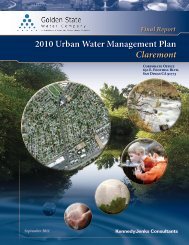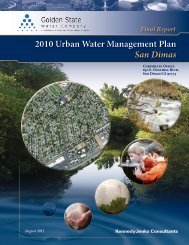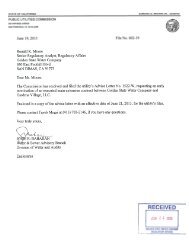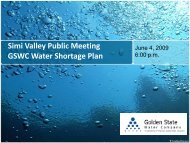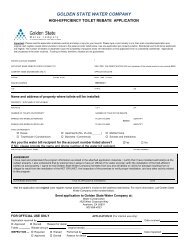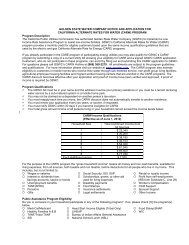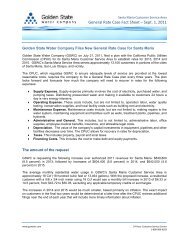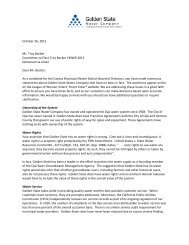Final Report, 2010 Urban Water Management Plan - Culver City
Final Report, 2010 Urban Water Management Plan - Culver City
Final Report, 2010 Urban Water Management Plan - Culver City
You also want an ePaper? Increase the reach of your titles
YUMPU automatically turns print PDFs into web optimized ePapers that Google loves.
5.2.1 Surface <strong>Water</strong> QualityThe entire supply for <strong>Culver</strong> <strong>City</strong> is obtained from treated surface water supply imported fromthe Metropolitan through three active connections (WB No. 23, WB No. 24, and WB No. 34).This is the primary source of water distributed in the system. Metropolitan is responsible formeeting all drinking water standards as water leaves the surface water treatment plant and at allinter-connections with the <strong>Culver</strong> <strong>City</strong> System.5.2.2 Groundwater QualityThere are currently three wells in the system, two are inactive and one is on standby status dueto water quality issues. A treatment system is being considered for the well.Table 5-1 summarizes water quality concerns for the groundwater wells in the <strong>Culver</strong> <strong>City</strong>System. All wells are currently on standby or are inactive due to water quality issues. Thefollowing discussion relates to contaminants with maximum containment levels (MCLs) that areeither existing or have been proposed by the U.S. Environmental Protection Agency (USEPA)and/or CDPH.Drinking water regulations pertaining to emerging contaminants of concern, such as chromium(VI), nitrosamines, and VOCs, and potential revisions to existing regulations are closelymonitored by GSWC’s Environmental Quality Department. The appropriate sampling and actionwill be taken on any affected water supply sources as monitoring requirements, new or revisedMCLs are promulgated by the USEPA or CDPH. It is anticipated that it will take approximately2 to 5 years from official adoption of a new or revised MCL to implement wellhead treatment oralternative approach for a source, including all steps from procuring CPUC funding approval toplanning, permitting, design, and construction. There is typically adequate time allotted fromregulatory approval to promulgation of a new drinking water standard to address localizedtreatment requirements; therefore no direct impacts to water supply reliability from future waterquality regulations are anticipated at this time.Table 5-1:Summary of AssessmentWellCurrentWellCapacity(gpm) (1)Status<strong>Water</strong> qualityissue/concernExistingTreatmentRecommendationsSentney No. 8 700 Standby Fe/Mn, BTEX, TDS Dual media filter VOC/TDS reductionCharnock No. 9 800 Inactive Fe/Mn, Hardness,TDS, MTBEDual media filterFull treatmentCharnock No. 10 1,500 Inactive Fe/Mn, Hardness,TDS, MTBEDual media filterFull treatmentNote:1. Estimated annual average current well production capacity is provided; actual and design instantaneous pumpingcapacity may be greater for each well.Page 5-2<strong>Final</strong> <strong>Report</strong>, <strong>2010</strong> <strong>Urban</strong> <strong>Water</strong> <strong>Management</strong> <strong>Plan</strong> – <strong>Culver</strong> <strong>City</strong>Golden State <strong>Water</strong> Companyg:\adminasst\jobs\<strong>2010</strong>\1070001.00_gswc-uwmp\09-reports\9.09-reports\2011-08\grp3\gswc_culvercity_<strong>2010</strong>_uwmp-final.doc




